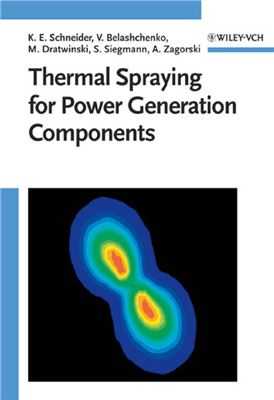Weinheim: WileyY-VCH, 2006. — 286 p.
Справочник по газотермическому напылению в энергетике, описаны
методы газотермического напыления , оборудование, технологии,
управление процессами напыления, контроль качества покрытий,
теоретические основы процессов и их моделирование.
Coatings constitute an intrinsic part of the power-generation
hardware. Thousands of patents, papers and conference presentations
address new coating types, new hardware and software, new process
developments, new chemical compositions. A huge unpublished
knowledge is stored in manufacturers “know-how”. However, sometimes
coatings are still considered as an “art” and there are fair
reasons for that. The thermal spray is still not a “plug and play”
tool and the product quality largely depends on the deep
understanding of process physics and hardware features, accumulated
experience, engineer’s intuition and operator’s training.
This book now deals with questions that are essential for a good performance of this “art”:
Is there a given process stability? What is the ratio of deterministic and stochastic in the coating process?
Is there an inherent process capability for a given specifi cation that cannot be improved?
What is the right preventive maintenance strategy?
Is there a chance to end up with coating-process capabilities in the order of other manufacturing processes?
What can be predicted and designed a priori by physical modeling and offl ine programming and what can be achieved by trial and error only?
What can be done to describe and control quality?
This book is not a pure scientifi c book. It is of most value for the engineer involved in design, processing and application of thermally sprayed coatings:
To understand the capability and limitations of thermal spraying, to understand deposition effi ciency – and the importance of maintenance and spare parts for quick changeover of wo equipment, to use offl ine programming and real equipment in an optimum mix to end up with stable processes in production after the shortest development time and in the end to achieve the fi nal target in production:
Process stability at minimum total cost
This book now deals with questions that are essential for a good performance of this “art”:
Is there a given process stability? What is the ratio of deterministic and stochastic in the coating process?
Is there an inherent process capability for a given specifi cation that cannot be improved?
What is the right preventive maintenance strategy?
Is there a chance to end up with coating-process capabilities in the order of other manufacturing processes?
What can be predicted and designed a priori by physical modeling and offl ine programming and what can be achieved by trial and error only?
What can be done to describe and control quality?
This book is not a pure scientifi c book. It is of most value for the engineer involved in design, processing and application of thermally sprayed coatings:
To understand the capability and limitations of thermal spraying, to understand deposition effi ciency – and the importance of maintenance and spare parts for quick changeover of wo equipment, to use offl ine programming and real equipment in an optimum mix to end up with stable processes in production after the shortest development time and in the end to achieve the fi nal target in production:
Process stability at minimum total cost

